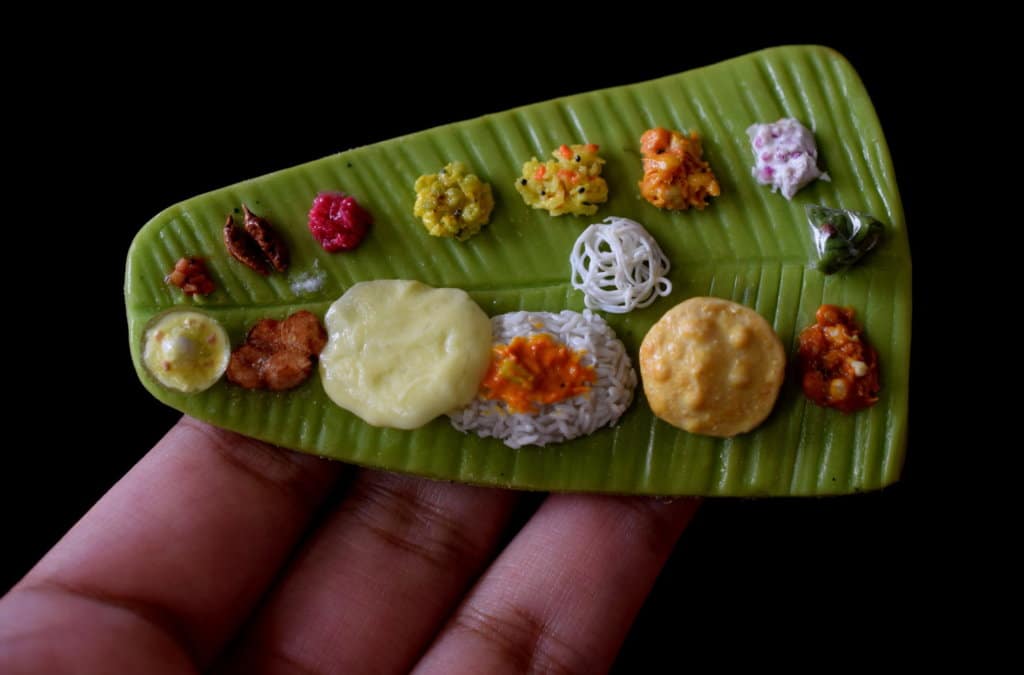A button-sized idli, one inch-long french fries, a miniscule plate of biryani, coin-sized bhature, a Kerala sadhya that you can hold with one finger — all made of clay. The unique offerings of Chennai-based sound engineer-turned-clay artist Shilpa Mitha are fast catching the fancy of people in India as well as abroad.
So much so, that her Instagram page got the attention of MasterChef Australia, and Australian celebrity chef Daniel Wilson contacted her for a signature Huxtaburger miniature for his restaurant in Melbourne. The following on social media got her more orders from abroad, especially if an Indian restaurant was being launched.
Mitha, however, muses that she fell into her career of making miniature clay art quite by accident. “I always dreamed of being a musician,” the 30-year-old artist tells Little India. “I had studied electronics and communication for graduation and did my diploma in audio engineering.”
As she was wondering how to go about making a career in music, she developed a hobby of making sculptures by using 3D paper quilling. One day, she wanted to make a pair of burger earrings for herself. “I thought it would be better if I make it with clay rather paper as clay is a more versatile medium. My mom is a crafter, so she helped with some clay and taught me the basics that day. She made most of the burger while I made the tomatoes and cheese,” she says.
The burger earrings were a hit. All her friends asked for a pair for themselves to buy. After the burger earrings, she tried making a cake. However, her turning point came with the first local food miniature – dosa. “It has been a slow self-taught journey since then,” she says, adding that she tried making an “okay looking sliced cucumber and lemon” for a satay just before the interview.
Mitha started Sueno Souvenir, an online store through which she sells her miniature food creations primarily as fridge magnets or collectibles, in 2011. “The beginning years were slow. I wasn’t actually focused on miniature food alone,” she recalls. “I had learnt to sculpt figurines so was dabbling in all forms of clay art. But after a while, I realized this is what someone might call — the inner calling! Funny though, that at no point of time in my life earlier, had I thought of a career in crafting. But once this happened, it just feels like this is what I’ve been meant to do all my life!”
Mitha primarily focuses on Indian cuisine, saying that while making miniature delicacies has been around for a while, Indian cuisine is new territory. “There’s so much to keep trying every day. You never run out of ideas over here,” she says.
Indeed, her enthusiasm is evident as she has tried her hands in all varieties of Indian cuisine — from South Indian dishes to Punjabi, Bengali and even North-eastern food. This, she feels, is a good way to introduce Indian food to the world.
“There’s more to our cuisine than curries! It’s a learning experience for me as well. Every town, city, state.. actually, every few kilometers away, there is something different. We are only familiar with a few famous dishes from each region but when you read more about them.. there’s a lot more!,” she points out.
Mitha avoids making curries as they tend to look similar. The miniatures, she believes, have to look “interesting” and draw attention to other details.
The process of making food miniatures is “very similar to cooking,” she says, involving the use of clay, acrylic and oil paints, sculpting tools and varnish for finishing. “You read the recipes, prepare the ingredients and then cook! Just that, I have to make my own ingredients as well,” she explains. “I look at picture of what I want to make, I go through their recipe and see what ingredients would be visible on the dish. I have to then sculpt them individually — the base, the plate or cup, then the food and its condiments.” She finally varnishes the creation. That also gives it an oily finish and makes it look like it has just been cooked.
The easiest miniature for her to now make is the dosa, which takes about 15 minutes. The hardest is biryani or thaalis with rice. Each rice grain has to be rolled individually. Mitha, who works close to 15 hours a day, uses toothpicks for precision. A complicated rice thaali can take as long as five days to make. Biryani is a different set of challenge, she says, in a country as diverse as India, since the preparation has different colors and textures in each region, and she has to achieve the exact look for Malabar biryani, Ambur biryani, and Hyderabadi biryani.
However, it is her South Indian food items — idli and dosa — that are her bestsellers. “People seem to be fascinated with them for some reason,” says Mitha.
The challenge for Mitha remains that the material she works with isn’t the one used to make miniatures. There are no tutorials to help her as Indian food hasn’t been done before, even though the art of making miniature food exploded as a phenomena in 2014 with the YouTube channel called Miniature Space.
She makes her miniatures on air dry clay, which nullifies the need for baking since its surface dries out soon. “It has the consistency of a chapati dough. So to shape them and to make them look as realistic as possible, it’s always challenging,” she says.
But these challenges are also the best part of her job, Mitha admits. “I won’t be having this sort of satisfaction had I got any kind of help in making these,” she says.
